
Landslide classification
Encyclopedia
There have been known various classifications of landslide
s and other types of mass wasting
.
For example, the McGraw-Hill Encyclopedia of Science and Technology
distinguishes the following types of landslides:
Differently, in landslide
classification, there are great difficulties due to the fact that phenomena are not perfectly repeatable; usually being characterised by different causes, movements and morphology, and involving genetically different material. For this reason, landslide classifications are based on different discriminating factors, sometimes very subjective.
In the following factors are discussed by dividing them into two groups: the first one is made up of the criteria utilised in the most widespread classification systems that can generally be easily determined. The second one is formed by those factors that have been utilised in some classifications and can be useful in descriptions
They can be deadly.
, earth and debris
are the terms generally used to distinguish the materials involved in the landslide
process. For example, the distinction between earth and debris
is usually made by comparing the percentage of coarse grain
size fractions. If the weight of the particles with a diameter greater than 2 mm is less than 20%, the material will be defined as earth; in the opposite case, it is debris
.
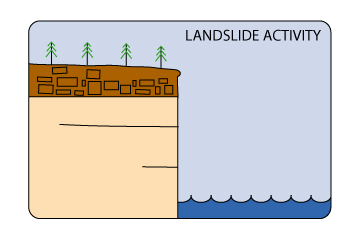
the distribution and the style. The first term describes the information regarding the time in which the movement took place, permitting information to be available on future evolution, the second term describes, in a general way, where the landslide is moving and the third term indicates how it is moving.
evaluation. A velocity
range is connected to the different type of landslides, on the basis of observation of case history or site observations.
dating is an interesting topic in the evaluation of hazard
. The knowledge of the Landslide frequency
is a fundamental element for any kind of probabilistic evaluation. Furthermore, the evaluation of the age of the landslide permits to correlate the to specific conditions, as earthquakes or periods of intense rains. It should be noted that, it is possible that phenomena could be occurred in past geological times, under specific environmental conditions which no longer act as agents today. For example, in some Alpine
areas, landslides of the Pleistocene
age are connected with particular tectonic, geomorphological and climatic conditions.
B2) Geological conditions
This represent a fundamental factor of the morphological
evolution of a slope
. Bedding attitude and the presence of discontinuities or faults control the slope
morphogenesis
.
landslides", "landslides in plains", "hilly landslides" or "cliff
landslides". As a consequence, specific morphological contexts are referred characterised by slope evolution processes.
in the genesis of phenomena for which similar geological conditions can, in different climatic conditions, lead to totally different morphological
evolution. As a consequence, in the description of a landslide, it can be interesting to understand in what type of climate the event occurred.
, the external causes generally induce an increase of shear stress
, so that block or bodies are no longer stable. The triggering causes induce the movement of the mass. Predisposition to movement due to control factors is determining in landslide evolution. Structural and geological factors, as already described, can determine the development of the movement, inducing the presence of mass in kinematic freedom.
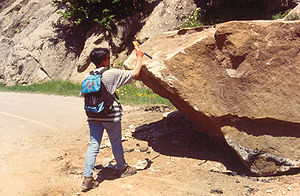 Description: "A fall starts with the detachment of soil or rock from a steep slope along a surface on which little or no shear displacement takes place. The material then descends mainly through the air by falling, bouncing, or rolling" (Varnes, 1996).
Description: "A fall starts with the detachment of soil or rock from a steep slope along a surface on which little or no shear displacement takes place. The material then descends mainly through the air by falling, bouncing, or rolling" (Varnes, 1996).
Secondary falls: "Secondary falls involves rock bodies already physically detached from cliff
and merely lodged upon it" (Hutchinson, 1988)
Speed: from very to extremely rapid
Type of slope: slope angle 45-90 degrees
Control factor: Discontinuities
Causes: Vibration, undercutting, differential weathering
, excavation, or stream erosion
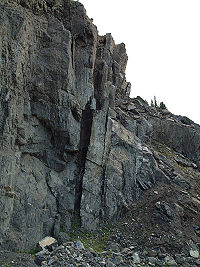 Description: "Topples is the forward rotation
Description: "Topples is the forward rotation
out of the slope of mass of soil or rock about a point or axis below the centre of gravity of the displaced mass. Toppling is sometimes driven by gravity exerted by material upslope of the displaced mass and sometimes by water or ice in cracks in the mass" (Varnes, 1996)
Speed: extremely slow to extremely rapid
Type of slope: slope angle 45-90 degrees
Control factor: Discontinuities, lithostratigraphy
Causes: Vibration, undercutting, differential weathering
, excavation, or stream erosion
or rock
mass occurring dominantly on the surface
of rupture or on relatively thin zones of intense shear strain." (Varnes, 1996)
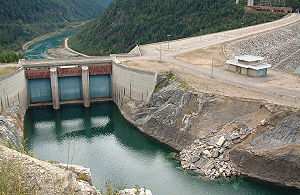
Speed: extremely slow to extremely rapid (>5 m/s)
Type of slope: slope angle 45-90 degrees
Control factor: Discontinuities, geological setting
Causes: Vibration
, undercutting, differential weathering
, excavation, or stream erosion
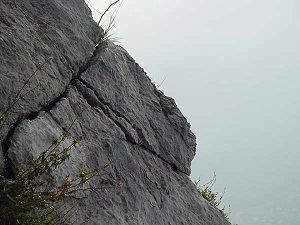
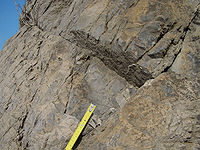
Speed: extremely slow to extremely rapid
Type of slope: slope angle 45-90 degrees
Control factor: morphology and lithology
Causes: Vibration
, undercutting, differential weathering
, excavation, or stream erosion
soil or rock mass combined with a general subsidence
of the fractured mass of cohesive material into softer underlying material." (Varnes, 1996).
"In spread, the dominant mode of movement is lateral extension accommodated by shear or tensile fractures" (Varnes, 1978)
Speed: extremely slow to extremely rapid (>5 m/s)
Type of slope: angle 45-90 degrees
Control factor: Discontinuities, lithostratigraphy
Causes: Vibration, undercutting, differential weathering
, excavation, or stream erosion
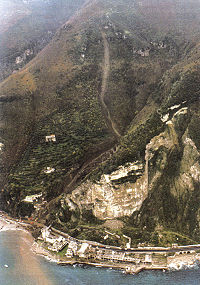
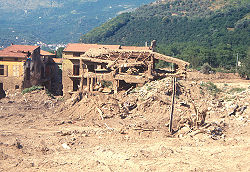
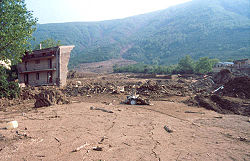
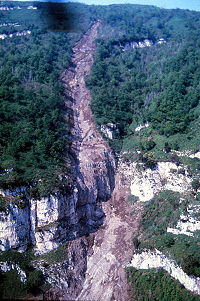 A is a spatially continuous movement in which surfaces of shear are short-lived, closely spaced, and usually not preserved. The distribution of velocities in the displacing mass resembles that in a viscous liquid. The lower boundary of displaced mass may be a surface along which appreciable differential movement has taken place or a thick zone of distributed shear (Cruden & Varnes, 1996)
A is a spatially continuous movement in which surfaces of shear are short-lived, closely spaced, and usually not preserved. The distribution of velocities in the displacing mass resembles that in a viscous liquid. The lower boundary of displaced mass may be a surface along which appreciable differential movement has taken place or a thick zone of distributed shear (Cruden & Varnes, 1996)
Description: "Flow movements in bedrock include deformations that are distributed among many large or small fractures, or even microfracture, without concentration of displacement along a through-going fracture" (Varnes, 1978)
Speed: extremely slow
Type of slope: angle 45-90 degrees
Causes: Vibration, undercutting, differential weathering
, excavation, or stream erosion
Description: "Extremely rapid, massive, flow-like motion of fragmented rock from a large rock slide or rock fall” (Hungr, 2001)
Speed: extremely rapid
Type of slope: angle 45-90 degrees
Control factor: Discontinuities, lithostratigraphy
Causes: Vibration, undercutting, differential weathering
, excavation or stream erosion
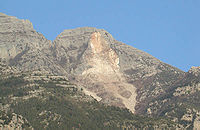
Description: "Debris flow
is a very rapid to extremely rapid flow of non-plastic debris
in a steep channel
" (Hungr et al.,2001)
Speed: very rapid to extremely rapid (>5 m/s)
Type of slope: angle 20-45 degrees
Control factor: torrent sediments, water flows
Causes: High intensity rainfall
Description: "Debris avalanche is a very rapid to extremely rapid shallow flow of partially or fully debris
on a steep slope
, without confinement in an established channel." (Hungr et al., 2001)
Speed: very rapid to extremely rapid (>5 m/s)
Type of slope: angle 20-45 degrees
Control factor: morphology, regolith
Causes: High intensity rainfalls
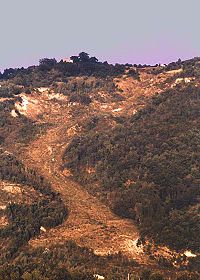
Description: "Earth flow is a rapid or slower , intermittent flow-like movement of plastic
, clayey earth." (Hungr et al.,2001)
Speed: slow to rapid (>1,8 m/h)
Type of slope: slope
angle 5-25 degrees
Control factor: lithology
Description: "Mudflow
is a very rapid to extremely rapid flow of plastic
debris in a channel, involving significantly greater water content relative to the source material (Plasticity index> 5%)." (Hungr et al.,2001)
Speed: very rapid to extremely rapid (>5 m/s)
Type of slope: angle 20-45 degrees
Control factor: torrent sediment
s, water flows
Causes: High intensity rainfall
Landslide
A landslide or landslip is a geological phenomenon which includes a wide range of ground movement, such as rockfalls, deep failure of slopes and shallow debris flows, which can occur in offshore, coastal and onshore environments...
s and other types of mass wasting
Mass wasting
Mass wasting, also known as slope movement or mass movement, is the geomorphic process by which soil, regolith, and rock move downslope under the force of gravity. Types of mass wasting include creep, slides, flows, topples, and falls, each with its own characteristic features, and taking place...
.
For example, the McGraw-Hill Encyclopedia of Science and Technology
McGraw-Hill Encyclopedia of Science and Technology
The McGraw-Hill Encyclopedia of Science & Technology isan English-language multivolume encyclopedia, specifically focused on scientific and technical subjects, and published by McGraw-Hill. The most recent edition in print is the tenth edition, copyright 2007 , comprising twenty volumes...
distinguishes the following types of landslides:
- fall (by undercutting)
- fall (by toppling)
- slump
- rockslideRockslideA rockslide is a type of landslide caused by rock failure in which part of the plane of failure passes through intact rock and where material collapses en masse and not in individual blocks.The mode of failure is different from that of a rock-fall....
- earthflowEarthflowAn earthflow is a downslope viscous flow of fine grained materials that have been saturated with water, and moves under the pull of gravity. They are an intermediate type of mass wasting that is between downhill creep and mudflow...
- rockslide that develops into rock avalanche
The used classification factors
Various scientific disciplines have developed taxonomic classification systems to describe natural phenomena or individuals, like for example, plants or animals. These systems are based on specific characteristics like shape of organs or nature of reproduction.Differently, in landslide
Landslide
A landslide or landslip is a geological phenomenon which includes a wide range of ground movement, such as rockfalls, deep failure of slopes and shallow debris flows, which can occur in offshore, coastal and onshore environments...
classification, there are great difficulties due to the fact that phenomena are not perfectly repeatable; usually being characterised by different causes, movements and morphology, and involving genetically different material. For this reason, landslide classifications are based on different discriminating factors, sometimes very subjective.
In the following factors are discussed by dividing them into two groups: the first one is made up of the criteria utilised in the most widespread classification systems that can generally be easily determined. The second one is formed by those factors that have been utilised in some classifications and can be useful in descriptions
A1) Type of movement
This is the most important criteria, even if uncertainties and difficulties can arise in the identification of movements, being the mechanisms of some landslides often particularly complex. The main movements are , and flows, but usually topples, lateral spreading and complex movements are added to these.They can be deadly.
A2) Involved material
RockRock (geology)
In geology, rock or stone is a naturally occurring solid aggregate of minerals and/or mineraloids.The Earth's outer solid layer, the lithosphere, is made of rock. In general rocks are of three types, namely, igneous, sedimentary, and metamorphic...
, earth and debris
Debris
Debris is rubble, wreckage, ruins, litter and discarded garbage/refuse/trash, scattered remains of something destroyed, or, in geology, large rock fragments left by a melting glacier etc. The singular form of debris is debris...
are the terms generally used to distinguish the materials involved in the landslide
Landslide
A landslide or landslip is a geological phenomenon which includes a wide range of ground movement, such as rockfalls, deep failure of slopes and shallow debris flows, which can occur in offshore, coastal and onshore environments...
process. For example, the distinction between earth and debris
Debris
Debris is rubble, wreckage, ruins, litter and discarded garbage/refuse/trash, scattered remains of something destroyed, or, in geology, large rock fragments left by a melting glacier etc. The singular form of debris is debris...
is usually made by comparing the percentage of coarse grain
GRAIN
GRAIN is a small international non-profit organisation that works to support small farmers and social movements in their struggles for community-controlled and biodiversity-based food systems. Our support takes the form of independent research and analysis, networking at local, regional and...
size fractions. If the weight of the particles with a diameter greater than 2 mm is less than 20%, the material will be defined as earth; in the opposite case, it is debris
Debris
Debris is rubble, wreckage, ruins, litter and discarded garbage/refuse/trash, scattered remains of something destroyed, or, in geology, large rock fragments left by a melting glacier etc. The singular form of debris is debris...
.
A3) Activity
The classification of a landslide based on its activity is particularly relevant in the evaluation of future events. The recommendations of the WP/WLI (1993) define the concept of activity with reference to the spatial and temporal conditions, defining the state,
the distribution and the style. The first term describes the information regarding the time in which the movement took place, permitting information to be available on future evolution, the second term describes, in a general way, where the landslide is moving and the third term indicates how it is moving.
A4) Movement velocity
This factor has a great importance in the hazardHazard
A hazard is a situation that poses a level of threat to life, health, property, or environment. Most hazards are dormant or potential, with only a theoretical risk of harm; however, once a hazard becomes "active", it can create an emergency situation. A hazard does not exist when it is not...
evaluation. A velocity
Velocity
In physics, velocity is speed in a given direction. Speed describes only how fast an object is moving, whereas velocity gives both the speed and direction of the object's motion. To have a constant velocity, an object must have a constant speed and motion in a constant direction. Constant ...
range is connected to the different type of landslides, on the basis of observation of case history or site observations.
B1) The age of the movement
LandslideLandslide
A landslide or landslip is a geological phenomenon which includes a wide range of ground movement, such as rockfalls, deep failure of slopes and shallow debris flows, which can occur in offshore, coastal and onshore environments...
dating is an interesting topic in the evaluation of hazard
Hazard
A hazard is a situation that poses a level of threat to life, health, property, or environment. Most hazards are dormant or potential, with only a theoretical risk of harm; however, once a hazard becomes "active", it can create an emergency situation. A hazard does not exist when it is not...
. The knowledge of the Landslide frequency
Frequency
Frequency is the number of occurrences of a repeating event per unit time. It is also referred to as temporal frequency.The period is the duration of one cycle in a repeating event, so the period is the reciprocal of the frequency...
is a fundamental element for any kind of probabilistic evaluation. Furthermore, the evaluation of the age of the landslide permits to correlate the to specific conditions, as earthquakes or periods of intense rains. It should be noted that, it is possible that phenomena could be occurred in past geological times, under specific environmental conditions which no longer act as agents today. For example, in some Alpine
Alpine climate
Alpine climate is the average weather for a region above the tree line. This climate is also referred to as mountain climate or highland climate....
areas, landslides of the Pleistocene
Pleistocene
The Pleistocene is the epoch from 2,588,000 to 11,700 years BP that spans the world's recent period of repeated glaciations. The name pleistocene is derived from the Greek and ....
age are connected with particular tectonic, geomorphological and climatic conditions.
B2) Geological conditions
This represent a fundamental factor of the morphological
Geomorphology
Geomorphology is the scientific study of landforms and the processes that shape them...
evolution of a slope
Slope
In mathematics, the slope or gradient of a line describes its steepness, incline, or grade. A higher slope value indicates a steeper incline....
. Bedding attitude and the presence of discontinuities or faults control the slope
Slope
In mathematics, the slope or gradient of a line describes its steepness, incline, or grade. A higher slope value indicates a steeper incline....
morphogenesis
Morphogenesis
Morphogenesis , is the biological process that causes an organism to develop its shape...
.
B3) Morphological characteristics
As the landslide is a geological volume with a hidden side, morphological characteristics are extremely important in the reconstruction of the technical model.B4) Geographical location
This criterion describe, in a general way, the location of landsides in the physiographic context of the area. Some authors have therefore identified landslides according to their geographical position so that it is possible to describe "alpineAlpine climate
Alpine climate is the average weather for a region above the tree line. This climate is also referred to as mountain climate or highland climate....
landslides", "landslides in plains", "hilly landslides" or "cliff
Cliff
In geography and geology, a cliff is a significant vertical, or near vertical, rock exposure. Cliffs are formed as erosion landforms due to the processes of erosion and weathering that produce them. Cliffs are common on coasts, in mountainous areas, escarpments and along rivers. Cliffs are usually...
landslides". As a consequence, specific morphological contexts are referred characterised by slope evolution processes.
B5) Topographical criteria
With these criteria, landslides can be identified with a system similar to that of the denomination of formations. Consequently, it is possible to describe a landslide using the name of a site. In particular, the name will be that of the locality where the landslide happened with a specific characteristic type.B6) Type of climate
These criteria give particular importance to climateClimate
Climate encompasses the statistics of temperature, humidity, atmospheric pressure, wind, rainfall, atmospheric particle count and other meteorological elemental measurements in a given region over long periods...
in the genesis of phenomena for which similar geological conditions can, in different climatic conditions, lead to totally different morphological
Geomorphology
Geomorphology is the scientific study of landforms and the processes that shape them...
evolution. As a consequence, in the description of a landslide, it can be interesting to understand in what type of climate the event occurred.
B7) Causes of the movements
In the evaluation of landslide susceptibility, causes of the s is an important step. Terzaghi describes causes as "internal" and "external" referring to modifications in the conditions of the stability of the bodies. Whilst the internal causes induce modifications in the material itself which decrease its resistance to shear stressShear stress
A shear stress, denoted \tau\, , is defined as the component of stress coplanar with a material cross section. Shear stress arises from the force vector component parallel to the cross section...
, the external causes generally induce an increase of shear stress
Shear stress
A shear stress, denoted \tau\, , is defined as the component of stress coplanar with a material cross section. Shear stress arises from the force vector component parallel to the cross section...
, so that block or bodies are no longer stable. The triggering causes induce the movement of the mass. Predisposition to movement due to control factors is determining in landslide evolution. Structural and geological factors, as already described, can determine the development of the movement, inducing the presence of mass in kinematic freedom.
Types and classification
In the following table shows a schematic landslide classification adopting the classification of Varnes 1978 and taking into account the modifications made by Cruden and Varnes, in 1996. Some integration have been made by using the definitions of Hutchinson (1988) and Hungr et al. 2001.| Type of movement | Type of material | ||||
| Bedrock | Engineering soils | ||||
| Predominantly fine | Predominantly coarse | ||||
| Falls | Rockfall | Earth fall | Debris fall | ||
| Topples | Rock topple | Earth topple | Debris topple | ||
| Slides | Rotational | Rock slump | Earth slump | Debris slump | |
| Translational | Few units | Rock block slide | Earth block slide | Debris block slide | |
| Many units | Rock slide | Earth slide | Debris slide | ||
| Lateral spreads | Rock spread | Earth spread | Debris spread | ||
| Flows | Rock flow | Earth flow | Debris flow | ||
| Rock avalanche | Debris avalanche | ||||
| (Deep creep) | (Soil creep) | ||||
| Complex and compound | Combination in time and/or space of two or more principal types of movement | ||||
Falls

Secondary falls: "Secondary falls involves rock bodies already physically detached from cliff
Cliff
In geography and geology, a cliff is a significant vertical, or near vertical, rock exposure. Cliffs are formed as erosion landforms due to the processes of erosion and weathering that produce them. Cliffs are common on coasts, in mountainous areas, escarpments and along rivers. Cliffs are usually...
and merely lodged upon it" (Hutchinson, 1988)
Speed: from very to extremely rapid
Type of slope: slope angle 45-90 degrees
Control factor: Discontinuities
Causes: Vibration, undercutting, differential weathering
Weathering
Weathering is the breaking down of rocks, soils and minerals as well as artificial materials through contact with the Earth's atmosphere, biota and waters...
, excavation, or stream erosion
Topples

Rotation
A rotation is a circular movement of an object around a center of rotation. A three-dimensional object rotates always around an imaginary line called a rotation axis. If the axis is within the body, and passes through its center of mass the body is said to rotate upon itself, or spin. A rotation...
out of the slope of mass of soil or rock about a point or axis below the centre of gravity of the displaced mass. Toppling is sometimes driven by gravity exerted by material upslope of the displaced mass and sometimes by water or ice in cracks in the mass" (Varnes, 1996)
Speed: extremely slow to extremely rapid
Type of slope: slope angle 45-90 degrees
Control factor: Discontinuities, lithostratigraphy
Lithostratigraphy
Lithostratigraphy is a sub-discipline of stratigraphy, the geological science associated with the study of strata or rock layers. Major focuses include geochronology, comparative geology, and petrology...
Causes: Vibration, undercutting, differential weathering
Weathering
Weathering is the breaking down of rocks, soils and minerals as well as artificial materials through contact with the Earth's atmosphere, biota and waters...
, excavation, or stream erosion
Slides
"A slide is a downslope movement of soilSoil
Soil is a natural body consisting of layers of mineral constituents of variable thicknesses, which differ from the parent materials in their morphological, physical, chemical, and mineralogical characteristics...
or rock
Rock (geology)
In geology, rock or stone is a naturally occurring solid aggregate of minerals and/or mineraloids.The Earth's outer solid layer, the lithosphere, is made of rock. In general rocks are of three types, namely, igneous, sedimentary, and metamorphic...
mass occurring dominantly on the surface
Surface
In mathematics, specifically in topology, a surface is a two-dimensional topological manifold. The most familiar examples are those that arise as the boundaries of solid objects in ordinary three-dimensional Euclidean space R3 — for example, the surface of a ball...
of rupture or on relatively thin zones of intense shear strain." (Varnes, 1996)

Translational slide
Description: "In translational slides the mass displaces along a planar or undulating surface of rupture, sliding out over the original ground surface." (Varnes, 1996)Speed: extremely slow to extremely rapid (>5 m/s)
Type of slope: slope angle 45-90 degrees
Control factor: Discontinuities, geological setting
Causes: Vibration
Vibration
Vibration refers to mechanical oscillations about an equilibrium point. The oscillations may be periodic such as the motion of a pendulum or random such as the movement of a tire on a gravel road.Vibration is occasionally "desirable"...
, undercutting, differential weathering
Weathering
Weathering is the breaking down of rocks, soils and minerals as well as artificial materials through contact with the Earth's atmosphere, biota and waters...
, excavation, or stream erosion


Rotational slides
Description: "Rotational slides move along a surface of rupture that is curved and concave" (Varnes, 1996)Speed: extremely slow to extremely rapid
Type of slope: slope angle 45-90 degrees
Control factor: morphology and lithology
Lithology
The lithology of a rock unit is a description of its physical characteristics visible at outcrop, in hand or core samples or with low magnification microscopy, such as colour, texture, grain size, or composition. It may be either a detailed description of these characteristics or be a summary of...
Causes: Vibration
Vibration
Vibration refers to mechanical oscillations about an equilibrium point. The oscillations may be periodic such as the motion of a pendulum or random such as the movement of a tire on a gravel road.Vibration is occasionally "desirable"...
, undercutting, differential weathering
Weathering
Weathering is the breaking down of rocks, soils and minerals as well as artificial materials through contact with the Earth's atmosphere, biota and waters...
, excavation, or stream erosion
Spreads
Description: "Spread is defined as an extension of a cohesiveCohesion (geology)
Cohesion is the component of shear strength of a rock or soil that is independent of interparticle friction.In soils, true cohesion is caused by one of three things:# Electrostatic forces in stiff overconsolidated clays...
soil or rock mass combined with a general subsidence
Subsidence
Subsidence is the motion of a surface as it shifts downward relative to a datum such as sea-level. The opposite of subsidence is uplift, which results in an increase in elevation...
of the fractured mass of cohesive material into softer underlying material." (Varnes, 1996).
"In spread, the dominant mode of movement is lateral extension accommodated by shear or tensile fractures" (Varnes, 1978)
Speed: extremely slow to extremely rapid (>5 m/s)
Type of slope: angle 45-90 degrees
Control factor: Discontinuities, lithostratigraphy
Lithostratigraphy
Lithostratigraphy is a sub-discipline of stratigraphy, the geological science associated with the study of strata or rock layers. Major focuses include geochronology, comparative geology, and petrology...
Causes: Vibration, undercutting, differential weathering
Weathering
Weathering is the breaking down of rocks, soils and minerals as well as artificial materials through contact with the Earth's atmosphere, biota and waters...
, excavation, or stream erosion
Flows




Rock Flow
Description: "Flow movements in bedrock include deformations that are distributed among many large or small fractures, or even microfracture, without concentration of displacement along a through-going fracture" (Varnes, 1978)
Speed: extremely slow
Type of slope: angle 45-90 degrees
Causes: Vibration, undercutting, differential weathering
Weathering
Weathering is the breaking down of rocks, soils and minerals as well as artificial materials through contact with the Earth's atmosphere, biota and waters...
, excavation, or stream erosion
Rock avalanche (Sturzstrom)
Description: "Extremely rapid, massive, flow-like motion of fragmented rock from a large rock slide or rock fall” (Hungr, 2001)
Speed: extremely rapid
Type of slope: angle 45-90 degrees
Control factor: Discontinuities, lithostratigraphy
Lithostratigraphy
Lithostratigraphy is a sub-discipline of stratigraphy, the geological science associated with the study of strata or rock layers. Major focuses include geochronology, comparative geology, and petrology...
Causes: Vibration, undercutting, differential weathering
Weathering
Weathering is the breaking down of rocks, soils and minerals as well as artificial materials through contact with the Earth's atmosphere, biota and waters...
, excavation or stream erosion

Debris flow
Description: "Debris flow
Debris flow
A debris flow is a fast moving, liquefied landslide of unconsolidated, saturated debris that looks like flowing concrete. It is differentiated from a mudflow in terms of the viscosity and textural properties of the flow. Flows can carry material ranging in size from clay to boulders, and may...
is a very rapid to extremely rapid flow of non-plastic debris
Debris
Debris is rubble, wreckage, ruins, litter and discarded garbage/refuse/trash, scattered remains of something destroyed, or, in geology, large rock fragments left by a melting glacier etc. The singular form of debris is debris...
in a steep channel
Channel (geography)
In physical geography, a channel is the physical confine of a river, slough or ocean strait consisting of a bed and banks.A channel is also the natural or human-made deeper course through a reef, sand bar, bay, or any shallow body of water...
" (Hungr et al.,2001)
Speed: very rapid to extremely rapid (>5 m/s)
Type of slope: angle 20-45 degrees
Control factor: torrent sediments, water flows
Causes: High intensity rainfall
Debris avalanche
Description: "Debris avalanche is a very rapid to extremely rapid shallow flow of partially or fully debris
Debris
Debris is rubble, wreckage, ruins, litter and discarded garbage/refuse/trash, scattered remains of something destroyed, or, in geology, large rock fragments left by a melting glacier etc. The singular form of debris is debris...
on a steep slope
Slope
In mathematics, the slope or gradient of a line describes its steepness, incline, or grade. A higher slope value indicates a steeper incline....
, without confinement in an established channel." (Hungr et al., 2001)
Speed: very rapid to extremely rapid (>5 m/s)
Type of slope: angle 20-45 degrees
Control factor: morphology, regolith
Regolith
Regolith is a layer of loose, heterogeneous material covering solid rock. It includes dust, soil, broken rock, and other related materials and is present on Earth, the Moon, some asteroids, and other terrestrial planets and moons.-Etymology:...
Causes: High intensity rainfalls

Earth flow
Description: "Earth flow is a rapid or slower , intermittent flow-like movement of plastic
Plastic
A plastic material is any of a wide range of synthetic or semi-synthetic organic solids used in the manufacture of industrial products. Plastics are typically polymers of high molecular mass, and may contain other substances to improve performance and/or reduce production costs...
, clayey earth." (Hungr et al.,2001)
Speed: slow to rapid (>1,8 m/h)
Type of slope: slope
Slope
In mathematics, the slope or gradient of a line describes its steepness, incline, or grade. A higher slope value indicates a steeper incline....
angle 5-25 degrees
Control factor: lithology
Lithology
The lithology of a rock unit is a description of its physical characteristics visible at outcrop, in hand or core samples or with low magnification microscopy, such as colour, texture, grain size, or composition. It may be either a detailed description of these characteristics or be a summary of...
Mudflow
Description: "Mudflow
Mudflow
A mudslide is the most rapid and fluid type of downhill mass wasting. It is a rapid movement of a large mass of mud formed from loose soil and water. Similar terms are mudflow, mud stream, debris flow A mudslide is the most rapid (up to 80 km/h, or 50 mph) and fluid type of downhill mass...
is a very rapid to extremely rapid flow of plastic
Plastic
A plastic material is any of a wide range of synthetic or semi-synthetic organic solids used in the manufacture of industrial products. Plastics are typically polymers of high molecular mass, and may contain other substances to improve performance and/or reduce production costs...
debris in a channel, involving significantly greater water content relative to the source material (Plasticity index> 5%)." (Hungr et al.,2001)
Speed: very rapid to extremely rapid (>5 m/s)
Type of slope: angle 20-45 degrees
Control factor: torrent sediment
Sediment
Sediment is naturally occurring material that is broken down by processes of weathering and erosion, and is subsequently transported by the action of fluids such as wind, water, or ice, and/or by the force of gravity acting on the particle itself....
s, water flows
Causes: High intensity rainfall

